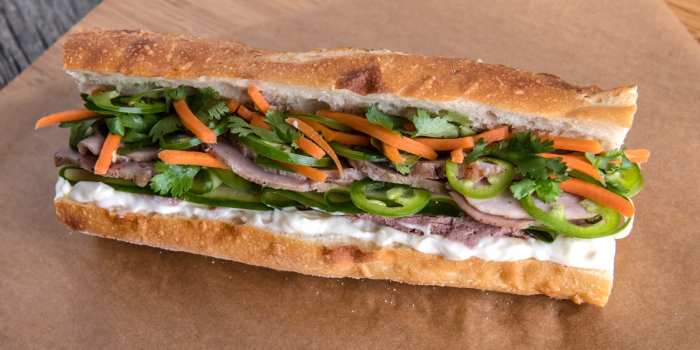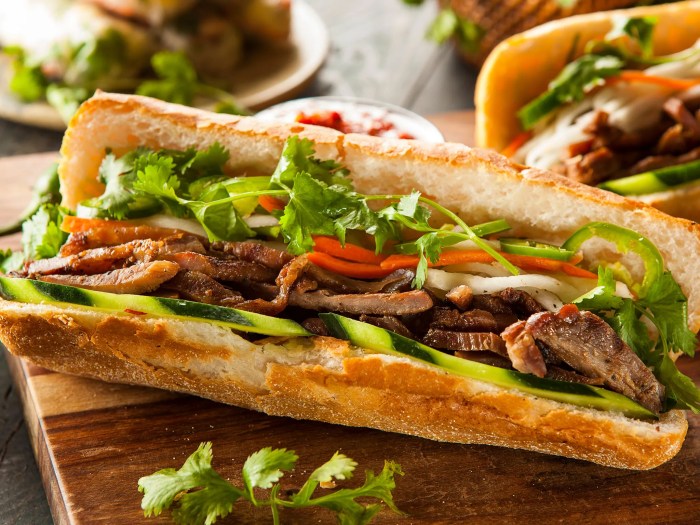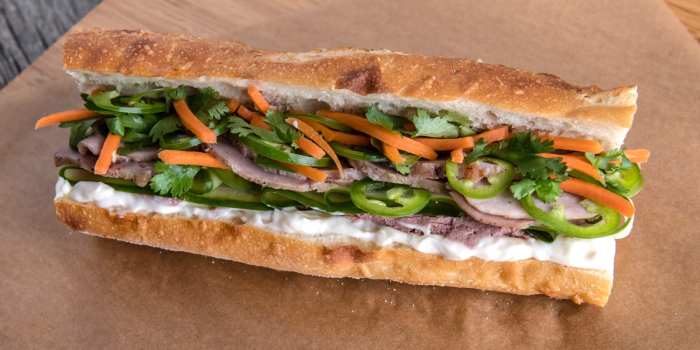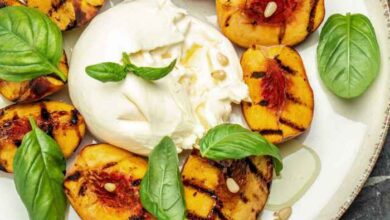
Vietnamese Banh Mi Sandwich: Make It at Home
Vietnamese banh mi sandwich home – Vietnamese Banh Mi Sandwich: Make It at Home – The aroma of toasted bread, the crunch of pickled vegetables, the savory richness of meat, and the tangy sweetness of aioli – these are the elements that make up a classic Vietnamese banh mi sandwich.
This iconic street food has captured hearts and stomachs worldwide, and it’s a delicious experience that’s surprisingly easy to recreate in your own kitchen.
Banh mi, meaning “bread” in Vietnamese, is a testament to the country’s culinary ingenuity. Its history is as rich and diverse as its flavors, tracing back to the French colonial era. The sandwich, a fusion of French bread and Vietnamese ingredients, has evolved into a beloved national treasure.
The History and Origins of Banh Mi
The banh mi sandwich, a beloved street food staple in Vietnam, boasts a rich history interwoven with the country’s cultural fabric. This iconic sandwich is more than just a delicious combination of flavors; it’s a testament to the resilience and adaptability of Vietnamese cuisine.
The Evolution of Banh Mi
The story of banh mi begins with the arrival of the French in Vietnam in the 19th century. The French introduced the baguette, a long, crusty loaf of bread, which quickly gained popularity among the Vietnamese people. The baguette provided a convenient and affordable source of sustenance, particularly in urban areas.
Over time, Vietnamese cooks began to experiment with the baguette, filling it with local ingredients like pickled vegetables, herbs, and meats. The combination of French bread and Vietnamese flavors gave birth to the banh mi sandwich, a culinary fusion that has become synonymous with Vietnamese street food.
The Cultural Significance of Banh Mi
Banh mi holds a special place in Vietnamese culture, reflecting the country’s history, ingenuity, and culinary creativity. It is a versatile and affordable food that can be enjoyed for breakfast, lunch, or dinner.
- Everyday Life:Banh mi is a common sight in Vietnamese cities and towns, sold by street vendors and small shops. It’s a quick and satisfying meal for busy workers, students, and families.
- Special Occasions:Banh mi is also served at weddings, birthdays, and other special events. It’s a symbol of Vietnamese hospitality and a way to share traditional flavors with guests.
The Origins of Banh Mi
While the exact origins of banh mi are debated, there are several interesting anecdotes and stories that shed light on its evolution.
- The “Banh Mi” Name:The term “banh mi” literally translates to “bread” in Vietnamese. The name reflects the French influence on Vietnamese cuisine, as “banh” (bread) is a French word borrowed into Vietnamese.
- The Street Food Origins:Banh mi is believed to have originated as a street food, sold by vendors who would fill baguettes with various ingredients. This affordability and convenience made it popular among the working class.
- The Post-War Influence:After the Vietnam War, many Vietnamese refugees brought their culinary traditions to other countries, including the United States. Banh mi became a popular food among Vietnamese communities abroad, further spreading its popularity and influencing other cuisines.
The Classic Banh Mi Recipe and Ingredients
The banh mi, a Vietnamese sandwich, is a delightful fusion of French bread and Southeast Asian flavors. This iconic street food has become a global phenomenon, loved for its crispy crust, flavorful fillings, and refreshing combination of textures. To recreate the magic of this beloved sandwich at home, we’ll delve into the essential ingredients and techniques.
My kitchen has become a mini-Banh Mi factory lately, with the aroma of pickled vegetables and cilantro filling the air. The only problem? All this deliciousness is making me feel a little guilty about my lack of exercise! Maybe I should check out is OBE Fitness worth it to help balance things out.
After all, a little sweat is a small price to pay for the satisfaction of a perfectly crafted Banh Mi.
The Bread
The foundation of any banh mi is the bread, which is typically a crusty, baguette-like loaf known as “banh mi” in Vietnamese. This bread is distinct from its French counterpart, featuring a thinner crust and a softer, more airy interior.
The texture is key: the crust should be crisp enough to provide a satisfying crunch, while the interior should be soft enough to hold the fillings without becoming soggy.
The Fillings
The fillings are where the banh mi truly shines, offering a symphony of flavors and textures. Here’s a breakdown of the essential components:
Meats
- Grilled Pork (Thịt Nướng):A popular choice, often marinated in a blend of fish sauce, garlic, and spices, resulting in a flavorful and tender meat.
- Char Siu Pork (Thịt Heo Quay):This sweet and savory roasted pork is a staple in many banh mi, adding a touch of sweetness and a delightful caramelized flavor.
- Vietnamese Ham (Giò Lua):A type of pork sausage with a slightly sweet and savory flavor, providing a satisfyingly dense texture.
- Chicken (Gà):Grilled or fried chicken can be a light and flavorful alternative, often seasoned with turmeric and lemongrass for a fragrant touch.
Vegetables
- Cucumbers (Dưa Leo):Thinly sliced cucumbers add a refreshing crunch and a hint of sweetness, balancing the richness of the other ingredients.
- Carrots (Cà Rốt):Pickled carrots bring a tangy and slightly sweet element, adding a burst of flavor and a vibrant color.
- Radishes (Củ Cải):Thinly sliced radishes offer a sharp and slightly peppery flavor, adding a contrasting element to the other ingredients.
- Cilantro (Ngò Gai):Fresh cilantro adds a bright and herbaceous flavor, enhancing the overall taste of the sandwich.
- Jalapeño Peppers (Ớt):For those who enjoy a kick, sliced jalapeño peppers add a spicy heat that complements the savory flavors.
Sauces
- Maggi Seasoning (Nước Mắm):A salty and umami-rich sauce that adds depth and complexity to the sandwich.
- Sriracha (Sốt Ớt):A spicy chili sauce that provides a fiery kick, adding a layer of heat to the sandwich.
- Mayonnaise (Mayonnaise):A creamy and tangy sauce that adds richness and smoothness to the sandwich.
Pickled Ingredients
- Pickled Daikon and Carrots (Dưa Leo Muối):This classic banh mi topping adds a tangy and crunchy element, providing a refreshing contrast to the other flavors.
- Pickled Onion (Hành Tây Muối):Adds a sharp and tangy flavor, complementing the savory fillings and enhancing the overall taste of the sandwich.
The Assembly, Vietnamese banh mi sandwich home
The assembly of a banh mi is a crucial step, as it determines the final taste and texture of the sandwich. Here’s a general guide:
1. Spread the sauce
Start by spreading a thin layer of mayonnaise and Maggi seasoning on the bottom half of the bread.
2. Add the meat
Layer the chosen meat on top of the sauce.
3. Add the vegetables
Arrange the cucumbers, carrots, radishes, and cilantro on top of the meat.
4. Add the pickled ingredients
Place the pickled daikon and carrots, and pickled onions on top of the vegetables.
5. Add the sriracha
Drizzle a few drops of sriracha sauce on top of the other ingredients.
6. Close the sandwich
Place the top half of the bread on top of the fillings, ensuring the sandwich is securely closed.
7. Slice and serve
Slice the banh mi in half and serve immediately.
Table of Fillings
| Filling | Flavor Profile | Origin |
|---|---|---|
| Grilled Pork (Thịt Nướng) | Savory, slightly sweet, smoky | Vietnamese |
| Char Siu Pork (Thịt Heo Quay) | Sweet, savory, caramelized | Cantonese (China) |
| Vietnamese Ham (Giò Lua) | Slightly sweet, savory, dense | Vietnamese |
| Chicken (Gà) | Savory, aromatic (turmeric, lemongrass) | Vietnamese |
| Cucumbers (Dưa Leo) | Refreshing, crunchy, slightly sweet | Vietnamese |
| Carrots (Cà Rốt) | Tangy, slightly sweet, crunchy | Vietnamese |
| Radishes (Củ Cải) | Sharp, slightly peppery, crunchy | Vietnamese |
| Cilantro (Ngò Gai) | Herbaceous, bright, refreshing | Vietnamese |
| Jalapeño Peppers (Ớt) | Spicy, hot, pungent | Mexican |
| Maggi Seasoning (Nước Mắm) | Salty, umami, savory | Southeast Asian |
| Sriracha (Sốt Ớt) | Spicy, hot, tangy | Thai |
| Mayonnaise (Mayonnaise) | Creamy, tangy, rich | French |
| Pickled Daikon and Carrots (Dưa Leo Muối) | Tangy, crunchy, refreshing | Vietnamese |
| Pickled Onion (Hành Tây Muối) | Sharp, tangy, crunchy | Vietnamese |
Making Banh Mi at Home

Bringing the vibrant flavors of Vietnam to your kitchen is easier than you think. With a few key ingredients and a little patience, you can recreate the magic of banh mi at home. This guide will take you through the essential steps, from marinating the meat to assembling the perfect sandwich, ensuring you capture the authentic taste of this iconic street food.
Marinating and Grilling Meat for Banh Mi
Marinating the meat is crucial for infusing it with flavor and achieving a tender, juicy texture. The most common banh mi fillings include grilled pork, lemongrass chicken, or tofu. Here are some tips for marinating and grilling:* Marinades:Traditional banh mi marinades often combine soy sauce, fish sauce, sugar, garlic, ginger, and chili peppers.
Experiment with different flavor profiles by adding ingredients like lemongrass, lime juice, or star anise.
Grilling Techniques
Use a grill pan or outdoor grill to achieve the characteristic char and smoky flavor. For best results, preheat the grill to medium-high heat and cook the meat for 2-3 minutes per side, ensuring it is cooked through.
The aroma of fresh cilantro and pickled vegetables always fills my kitchen when I’m making a batch of banh mi sandwiches at home. It’s a labor of love, and sometimes I find myself craving a simpler culinary adventure. That’s when I turn to homemade baby food in minutes , which is a breeze to whip up and always a hit with my little one.
But nothing beats the satisfaction of sinking my teeth into a perfectly crafted banh mi, bursting with flavor and textures.
Making Homemade Pickled Vegetables
The pickled vegetables, often a combination of carrots, daikon radish, and cucumbers, provide a refreshing crunch and tangy contrast to the rich flavors of the banh mi. Here’s how to make your own:* Ingredients:For a basic pickle, you’ll need shredded carrots, daikon radish, and cucumbers, along with rice vinegar, sugar, salt, and a pinch of chili flakes for extra spice.
Process
Combine the shredded vegetables with the vinegar, sugar, salt, and chili flakes in a jar. Allow the mixture to sit at room temperature for at least 30 minutes or overnight in the refrigerator for a stronger flavor.
Assembling the Perfect Banh Mi
Now comes the fun part: assembling the sandwich! Here’s a step-by-step guide:* Bread:Choose a crusty baguette with a soft interior. If possible, opt for a baguette specifically designed for banh mi.
Spreads
My kitchen has become a haven for Vietnamese banh mi sandwiches, a place where I experiment with different combinations of pickled vegetables, fresh herbs, and meats. Sometimes I even like to wear something unexpected in the kitchen, like a colorful apron with a whimsical pattern.
It’s all about embracing the unexpected, just like the surprising flavors in a perfect banh mi.
Start with a thin layer of mayonnaise or pâté, followed by a generous helping of your chosen grilled meat.
Pickled Vegetables
Add a generous amount of pickled carrots, daikon radish, and cucumbers for that essential crunch and tang.
Other Toppings
Layer on fresh cilantro, jalapeños, and a sprinkle of fresh chilies for a final burst of flavor.
Cilantro and Chili
A sprinkle of fresh cilantro and a dash of chili powder add a touch of freshness and heat.
Variations and Modern Interpretations of Banh Mi

The classic banh mi, with its simple yet delicious combination of ingredients, has become a culinary icon. However, the world of banh mi extends far beyond this basic formula, encompassing a wide range of regional variations and modern interpretations. From the bustling streets of Hanoi to the vibrant markets of Saigon, each region in Vietnam boasts its own unique take on the banh mi, showcasing local ingredients and flavors.
And in recent years, chefs and food enthusiasts have embraced the banh mi’s versatility, experimenting with innovative fillings and fusion creations.
Regional Variations of Banh Mi
Regional variations of banh mi reflect the diverse culinary traditions and local ingredients found across Vietnam. These variations offer a glimpse into the richness and complexity of Vietnamese cuisine, showcasing the adaptability of the banh mi to different tastes and preferences.
- Hanoi:Known for its delicate and refined flavors, Hanoi’s banh mi often features a combination of pickled vegetables, cilantro, and a thin slice of pate, all nestled within a crusty baguette. The emphasis is on fresh, clean flavors, allowing the individual ingredients to shine through.
- Hue:Hue, the former imperial capital of Vietnam, is renowned for its rich culinary heritage, and its banh mi reflects this tradition. Hue’s banh mi often incorporates ingredients like grilled pork, pickled daikon and carrots, and a savory, slightly sweet nuoc cham sauce.
- Saigon:Saigon, Vietnam’s largest city, is a melting pot of cultures and flavors. Saigon’s banh mi is known for its bold and savory flavors, often featuring grilled meats, pickled vegetables, and a generous amount of chili sauce.
- Da Nang:Da Nang, a coastal city in central Vietnam, is famous for its seafood, and its banh mi reflects this local bounty. Da Nang’s banh mi often features grilled fish, shrimp, or squid, along with pickled vegetables and a spicy, tangy dipping sauce.
Modern Interpretations of Banh Mi
The banh mi’s versatility has inspired chefs and food enthusiasts to experiment with innovative fillings and fusion creations, resulting in a wide range of modern interpretations. These modern banh mi creations often blend traditional Vietnamese flavors with international influences, pushing the boundaries of the classic sandwich.
- Fusion Flavors:Modern banh mi often incorporate ingredients from other cuisines, creating unexpected and delicious flavor combinations. Examples include Korean bulgogi, Japanese teriyaki chicken, or even Italian prosciutto and mozzarella.
- Vegetarian and Vegan Options:The banh mi is easily adaptable to vegetarian and vegan diets. These variations often feature tofu, tempeh, or seitan, along with a variety of fresh vegetables and flavorful sauces.
- Elevated Ingredients:Some modern banh mi creations feature elevated ingredients, such as artisanal bread, premium meats, and gourmet cheeses. These variations showcase the banh mi’s potential as a sophisticated and elegant sandwich.
Comparing Traditional and Modern Banh Mi
While traditional banh mi remains a beloved classic, modern interpretations offer a fresh perspective on this iconic sandwich. While traditional banh mi emphasizes simplicity and regional flavors, modern variations often push the boundaries of culinary creativity, blending traditional Vietnamese flavors with international influences.
| Characteristic | Traditional Banh Mi | Modern Banh Mi |
|---|---|---|
| Ingredients | Simple, regional ingredients | Innovative, fusion ingredients |
| Flavor Profile | Balanced, savory, slightly sweet | Bold, diverse, experimental |
| Presentation | Rustic, street food aesthetic | Sophisticated, gourmet presentation |
Banh Mi as a Cultural Icon: Vietnamese Banh Mi Sandwich Home

Banh mi, the iconic Vietnamese sandwich, has transcended its humble origins to become a global phenomenon, capturing palates and hearts around the world. Its journey from a simple street food to a culinary symbol of Vietnamese culture is a testament to its irresistible flavors and the enduring power of food to connect people across cultures.
Banh Mi’s Global Popularity and Influence
Banh mi’s popularity extends far beyond Vietnam, with dedicated banh mi shops popping up in major cities across the globe. This widespread appeal is a result of its versatility, adaptability, and ability to cater to diverse tastes. Banh mi’s popularity is not merely a reflection of its deliciousness; it also speaks to its ability to resonate with a global audience seeking authentic and flavorful experiences.
Banh Mi as a Symbol of Vietnamese Cuisine
Banh mi has become synonymous with Vietnamese cuisine, serving as a culinary ambassador that introduces the world to the vibrant flavors and traditions of Vietnamese gastronomy. Its ingredients, from the crusty baguette to the savory fillings, are a testament to the ingenuity and resourcefulness of Vietnamese cooks.
The sandwich’s unique combination of sweet, savory, and spicy elements showcases the diverse and dynamic nature of Vietnamese cuisine.
Banh Mi’s Role in Cultural Exchange and Understanding
Banh mi plays a significant role in promoting cultural exchange and understanding by bridging culinary traditions and fostering connections between people from different backgrounds. Its popularity in international food markets has led to a growing appreciation for Vietnamese culture, with people eager to learn more about the history, traditions, and culinary heritage behind this beloved sandwich.
Banh Mi in Art, Literature, and Popular Culture
Banh mi’s cultural impact extends beyond the realm of food, with its presence felt in art, literature, and popular culture. It has been featured in numerous books, films, and television shows, showcasing its role in Vietnamese life and its appeal to a global audience.
Banh mi’s inclusion in popular culture is a testament to its enduring appeal and its ability to transcend language and cultural barriers.





